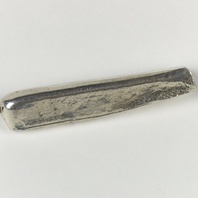
Viking Objects
Reproduction Silver Ingot
A white metal reproduction of a Viking Age silver ingot. Silver goods and coins might be melted down into ingots for ease of carrying.
Read More
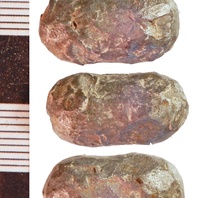
Viking Objects
Silver Ingot (NLM-ABB952)
This silver ingot was made by melting down worked silver and casting it in a mould. The Vikings arriving in England had a bullion economy in which they paid for goods with silver that was weighed to an amount agreed between the buyer and the seller. Hacksilver and silver ingots are the most common evidence for their bullion economy. It took some time for the Scandinavian settlers to adopt a monetary economy like that of the Anglo-Saxons, and both systems were used simultaneously for a while before they fully adopted the new system. The Vikings were familiar with monetary economies but they treated coins as just another form of silver before adoption of a monetary economy.
Read More
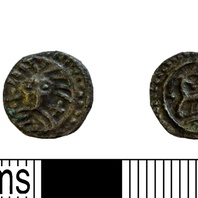
Viking Objects
Danish Silver Sceat (NARC-70AFF4)
This silver sceat is classified as part of the Danish Series X Type 31. The obverse depicts the head of Woden with crosses to either side of a rounded beard and pellet above. The reverse depicts a monster facing left. These coins are considered to be associated with the early trading center at Ribe. It is very likely that they made their way to England by means of Vikings.
Read More
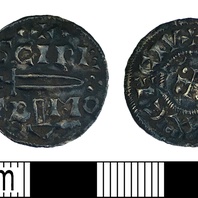
Viking Objects
Silver Viking Penny (DENO-FCA770)
This is a silver penny of a type know as the St Peter Sword/Cross type which bears an inscription to St Peter of York (c. 905-927) and was minted at York between 921 and 927. Viking rulers in the Danelaw eventually took up the Anglo-Saxon practice of minting coins which helped legitimise their authority.
Read More
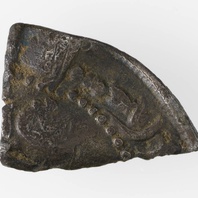
Viking Objects
Abbasid Silver Dirham Fragment (CM_1775_2008)
A silver dirham fragment possibly minted at al-`Abbasiyya. The dirham was a unit of weight used across North Africa, the Middle East, and Persia, with varying values which also referred to the type of coins used in the Middle East during the Viking Age. These coins were extremely prized possessions not only for their silver value but as a way of displaying one’s wealth and vast trade connections. Millions of Arabic dirhams would have been imported throughout the Viking world and are mostly found in hoards.
Read More
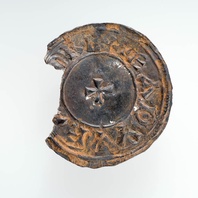
Viking Objects
Edward the Elder Penny (CM.615-1998)
A Horizontal type (HC1) silver penny of Edward the Elder (874-924), son of Alfred the Great, and minted by a moneyer called Beornwald. This coin was part of a hoard of twelve coins found at Thurcaston between 1992 and 2000. The coins are Anglo-Saxon, Arabic and Viking issues, and show the diverse and wide-ranging contacts between societies at this time. The hoard was probably deposited c.923-925, approximately five years after Leicester had been retaken by Mercia (c.918). They indicate that a bullion economy was still operating in the Danelaw as late as the 920s. This suggests that the reconquest did not immediately manage to institute Anglo-Saxon practices such as a monetary economy.
Read More
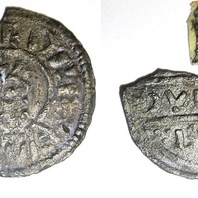
Viking Objects
Coin of Burghred of Mercia (1989-58/3650)
A silver penny of Burghred of Mercia, found in the mass grave at Repton, minted by the moneyer Dudwine. Dudwine may be the same moneyer who was minting coins for Alfred the Great at a later date. Burghred was king of Mercia from 852-874 CE. He was driven out of Mercia by the Vikings during their march from Lindsey to Repton in 874 after they sacked Tamworth. Burghred fled to Rome, where he eventually died, and was replaced by Ceowulf II who was loyal to the Vikings. Minting coins was a way of controlling the means of exchange within a kingdom and which created a more easily administered standardized system of trade. Moreover, the coins themselves were often used as propaganda, portaying symbols and statements that gave off a desired message. The Vikings later used the minting of coins to legitimize their own rule.
Read More
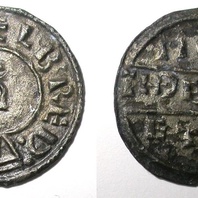
Viking Objects
Coin of Alfred the Great (1989-58/3386)
A silver penny of Alfred the Great, found in the mass grave at Repton, was minted by a moneyer called Tidhelm in London. Alfred was King of Wessex from 871 to 899 and spent most of his reign fighting off Viking invasions. He won a decisive victory at the Battle of Edington in 878 which resulted in a peace with the Vikings and the creation of the Danelaw. Minting coins was a way of controlling the means of exchange within a kingdom and which created a more easily administered standardized system of trade. Moreover, the coins themselves were often used as propaganda, portraying symbols and statements that gave off a desired message. The Vikings later used the minting of coins to legitimize their own rule.
Read More
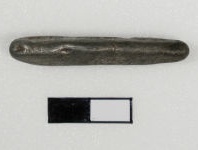
Viking Objects
Silver Ingot (2010-195)
Ingots of this size and shape were used as a convenient way to store and carry silver in the Viking Age. They might be cut up into pieces (hacksilver) to be used as bullion for payments, or be processed into jewellery. Analysis of silver ingots from this period shows that many were made from silver mined in the Middle East. This silver was probably originally used to mint Arabic dirhams (a type of coin) but was melted down by the Vikings to make it more easily portable.
Read More
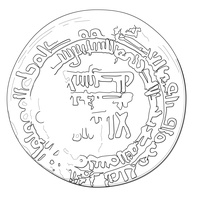
Viking Designs
Drawing of an Arabic Coin
Drawing of an Arabic silver dirham minted in the Middle East and probably brought to Lincolnshire by Viking traders. The dirham was a unit of weight used across North Africa, the Middle East, and Persia, with varying values which also referred to the type of coins used in the Middle East during the Viking Age. These coins were extremely prized possessions not only for their silver value but as a way of displaying one’s wealth and vast trade connections. Millions of Arabic Dirhams would have been imported throughout the Viking world and are mostly found in hoards. Arabic dirhams demonstrate contact between the Viking diaspora and the Arabic world. Arabic coins are especially useful for dating sites, because they carry the date when they were minted. This permits precise dating where the part of the coin with the date survives, whereas European coins can only be dated to the reign of the ruler depicted on them. In western descriptions of these coins, the Arabic dates found on the coins are usually listed in square brackets, as above, and the European equivalent is listed after it.
Read More
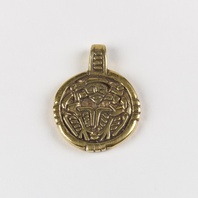
Viking Objects
Reproduction Pendant with an Odin Motif
This reproduction of a cast silver, gilded pendant featuring an image of a one-eyed figure with two birds has been interpreted as Odin and his two ravens, Huginn and Muninn. The original pendant was found at Winteringham, Lincolnshire. There are a number of close parallels which establish the wide currency of this subject group. These include numerous examples from Russia and two from Sweden, including some with silver gilding. A silver pendant with a related, but distinct design is known from Sjælland, Denmark.
